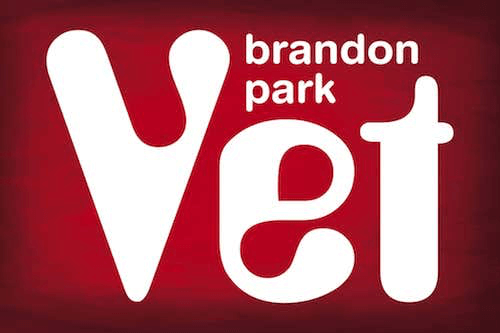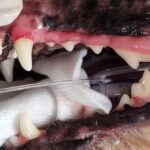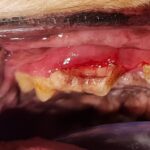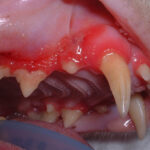POST-OPERATIVE INFORMATION AND INSTRUCTIONS
Tibial Plateau Leveling Procedure / Tibial Wedge Ostectomy
SURGERY:
A tibial Plateau leveling procedure aims to reduce the instability of the stifle joint after tearing or rupture of the Anterior Cruciate Ligament. Another important aspect of surgery is to fully assess the joint for any additional cartilage damage, and address this at the same time if needed.
An Arthrotomy (joint surgery) has been performed to explore the joint, and clean out the damaged ligament (and Cartilage).
A Closing Wedge Tibial Ostectomy has been performed to level the tibial plateau, with the use of the latest design of Stainless-Steel locking plates and screws, for added strength.
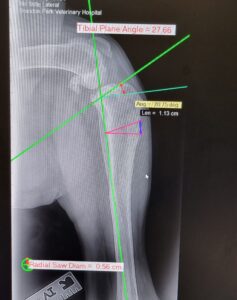
Bio-mechanically, this procedure leads to increased joint stability, and more importantly reduces further joint damage and degeneration in the future, which ultimately results in less pain, better function, and less arthritis.
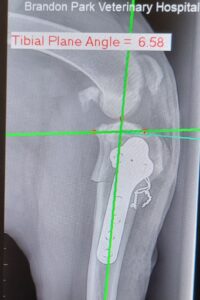
Given the nature of cruciate ligament disease, any underling or developing osteoarthritis and degenerative joint disease will still need to be managed.
RECOVERY
We will work together over the next few weeks/months to ensure that recovery goes as smooth as possible.
Post-operative care at home is very important to a successful and speedy recovery, with minimal complication. Recovery will be affected by several factors, including the extent of the damage, if there was concurrent cartilage damage, and if there was evidence of chronic joint disease/arthritis present at the time of diagnosis.
In our experience many dogs will be placing a good amount of weight, and using the leg, within the first 1-2 weeks after surgery. We aim to slowly build on this to a consistent walk over weeks 2-4, as well as improving mobility and muscle strength.
Most dogs will want to be more active than they should, however, it is important to remember that there is still a lot of healing and strengthening to happen. Whilst most will have good strength within the first 3-4 months, full strength can take about 6 months (or more), particularly in those with underlying joint disease and arthritis as well.
HOME CARE
Recovering patients need to be STRICTLY rested and confined to an area the size of a small laundry or child play-pen for the first two weeks following surgery. They should not be allowed to walk around on their own.
It is also important to;
- Ensure there is secure footing on hard floors, use of non-slip mats or rugs will help.
- Maintain a low excitement environment so there is no jumping or access to any stairs, hallways, back yard etc. Most patients remain quiet most of the time, however it only takes a few minutes of activity or a small run that can increase the risk of complications. (for example, darting down the corridor if the doorbell rings)
- NO jumping, (up onto people/furniture, into cars etc.),
- Avoid access to any stairs/steps
- Ensure that they are not licking the wound.
Movement is also important, and several short toilet trips throughout the day are encouraged. Please ensure they are always on lead, and supervised, until advised.
It is important to note that during this surgery, the bone has been cut, re-angled and secured into a new position. Bone takes 12-16weeks to heal, and excessive activity in the healing phase can delay healing and lead to complications such as implant failure
Always think about what could they do, and take steps to prevent any running and jumping.
THINGS TO KEEP IN MIND
- Best healing will occur with time and a slow, controlled buildup of activity.
- Many dogs can feel good after 2-3 weeks and want to run and play so stay in control of their confinement, and pay attention to where they will be spending their time.
- The risk of infection has been kept to a minimum by our surgical and antibiotic protocol. Licking of the wound however can increase the risk of infection, so it is important to not allow licking. The use of an Elizabethan collar would be advisable.
- Pain: the pain management plan will aim to minimize the level of pain, particularly in the first 2 weeks after surgery. We want to ensure patients are comfortable, so that we can get them into their exercise program early.
Pain levels will be assessed at each weekly visit, but please don’t hesitate to call if you feel pain levels are increasing.
- Wound breakdown: licking, and worse, chewing of the wound can not only lead to infection of the skin, but some pets can cause the wound to open. Please ensure an Elizabethan collar.
MEDICATIONS:
Pain Relief:
A combined approach and the use of pre-emptive pain relief greatly improves post-operative comfort levels.
Opioids
- Methadone pain relief injection before and after surgery
- A stronger opioid, Fentanyl pain relief patch has also been applied and will last for 5-7 days.
- Fentanyl can make some patients feel a little nauseated and may need to be removed early if they are not eating well after surgery.
Intra-articular
- Intra-articular injections of a local anesthetic and Synovan joint support have also been used at the time of surgery.
Anti-inflammatories
- An intravenous anti-inflammatory injection has been given immediately after surgery.
- In addition, there will be an oral take home course please give as directed.
- Generally, we will aim to reduce the frequency of these medications over a 2–4-week period.
Additional Pain relief, such as Gabapentin may also be provided, to be given for the first few days.
Antibiotics: Noroclav Oral tablets
- After having three intravenous antibiotic injections during their hospital stay, an oral take-home course will also be provided. This greatly reduced the chance of post op infections.
Joint Support measures
Synovan: Synovan injections will aid the healing process in the short-term, but more importantly they can reduce the progression of arthritis, reduce pain and inflammation and subsequent joint disease that develops following such injuries
- The initial course involves one injection, once weekly for 4 weeks.
- Maintenance treatment is recommended whenever a joint has been damaged. An initial booster is recommended at 8 weeks followed by and maintenance boosters every 3 months.
Beransa is one of the newest treatments for managing painful damaged joints. It is what is termed a Biologic treatment and is a Monoclonal Antibody which greatly reduces joint pain, and inflammation. Beransa is given as a monthly injection, and would be recommended for a few months after surgery.
FOLLOW UP VISITS
- We will arrange four weekly visits after surgery for reassessment, rehab, Laser treatment and Synovan injections.
- Rehabilitation: those pets undergoing weekly rehab sessions will be required to stay for a few hours during the morning of their visit.
- Follow up X-rays
Depending on their progress this will generally be taken at 8-12 weeks post-surgery.
In some cases, we may take one at 4 weeks should they be very active dogs, or any concerns with healing.
REHABILITATION / Post-operative Treatment
The Recovery period is as important as the surgery. As mentioned, we off a 4-week Rehab program tailored to each patient’s rate of recovery. This will involve 4 weekly day visits in to the hospital.

During these sessions a combination of techniques are used to improve healing and comfort levels
- Laser Therapy – a pain free drug free alternative.
- Promotes faster healing
- Reduced inflammation
- Reduces pain
- Massage – we all know the benefits of massage to reduce tension and pain
- Movement and mobilization exercises: encourages earlier use and improves mobility
After each session we will update you on their progress, and suggest a few exercises to do at home as well.
HOME CARE PLAN
These are generalized guidelines, which will vary with each patient and level of progress. It is also understandable that it is not always possible or practical to always stick to routines every day. If you have any doubts about the level of activity your pet is doing, please get in touch, and in the meantime, less activity is always better than more.
Week 1: strict confinement to a small area/pen
- Take out to toilet on a lead several times per day
- Ice pack and Gentle massage of the operated leg.
- Regular short 5min walks around the garden are encouraged to improve joint motion
Week 2-3:
- Short lead walks can continue 10-15 minutes, twice daily
- Walks can be outside, down the street, but ensure they are at a slow and steady walking pace.
- Keep confined to a small room, or area, at other times.
- Use of a harness or long lead inside can help, if they would like to be with the family inside.
- Light strengthening exercises can begin. Like repetitive sit-to-stand.
Do not allow running or off-lead activity, even in the yard as they can suddenly take off, causing more damage or increased pain.
Week 4-5: Walks can be increased to about 20 min twice daily.
- A little time to walk around the house should be OK, but always under supervision.
- When not supervised, confinement in low excitement environment such as a small room is still advised.
- No off-lead exercise at this stage.
- Mobility and strengthening exercises can begin (and will be discussed)
Week 7- 8: Lead walks can be increased to 20-30min twice daily. No off-lead activity.
- House confinement would be recommended.
- Back Yard time should be supervised.
- Off lead running should be avoided
- Continue sit-to-stand and figure 8 exercises
Weeks 8-12: Continue lead walks increasing to 30-40min twice daily.
- No off lead running yet
- Jogging on lead can begin
- House confinement is still advisable.
Week 12 and beyond
By 12 weeks the bone should have healed, and we should be able to start off-lead activity.
This will however depend on the level of comfort, and how much strength has been regained.
- Take it slow
- Once they get the green light they will be full speed, and the muscles and joint does still need to regain full strength, which can take upwards of 6 months.
- It is expected that increased activity can lead to days of increased stiffness, so please take it slow.
- If there is any increased soreness rest and controlled activity should recommence until advised.
Weight control:
- Given the nature of these joint problems quite often both legs can be affected with larger breeds and overweight pets having a much higher chance of injuring the opposite leg within the first 12months.
- The extra weight leads to more wear and tear on joints therefore weight management and controlled exercise is an equally important part of a successful recovery.
LONGER TERM MANAGEMENT OF JOINT DISEASE
As with all joint injuries a degree of joint degeneration and osteoarthritis will naturally take place. Cruciate ligament rupture often occurs secondary to degenerative joint disease with many dogs having a considerable number of changes to the joint evident at time of diagnosis and surgery. The amount of osteoarthritis depends on the duration and extent of the injury.
Current statistics show that about 50% of large breed dogs will damage the opposite leg within 6-12 months. Furthermore about 50% tend to have further cartilage and meniscal damage within 6 months of a cruciate ligament tear.
Whilst a tibial plateau leveling procedure is the gold standard to address cruciate ligament tears and stifle instability, it is only the first step to managing these problems. Surgery does greatly improve the health of the joint and reduce ongoing damage, however it is expected that there will be some joint degeneration over time.
Therefore, other preventative measures are greatly beneficial to help slow down the progression of the joint damage and therefore improve joint health of both stifle joints for the long term.
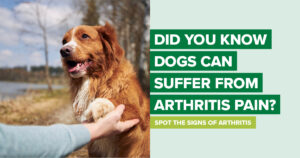
A management plan is beneficial and includes the use of
- Anti-inflammatories initially for added pain relief,
- Synovan/Pentosan – clinically proven to improve joint health and slow down degenerative processes.
- Antinol natural anti-inflammatory – also shown to help with reducing ongoing joint degeneration and promotes healthier cartilage
- Joint diet such as J/D which has been clinically proven to slow down the arthritic damage that occurs after such injuries, and has added benefits of improving muscle mass and tone, as well as reducing joint pain. Other forms of glucosamine, chondroitin and antioxidants (omega 3) which help cartilage health.
- Weight Control
Please do not hesitate to call if you have any further questions or concerns.
